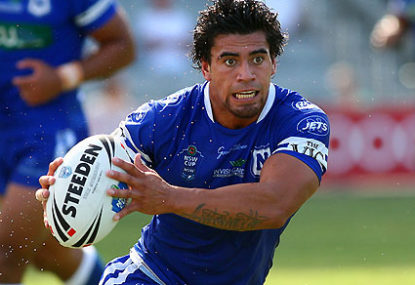Dear Davo Smithy, I for one welcomed recent news that a thorough review of the second tiers is currently in progress. Still, obvious questions do arise.
Can our sport actually sustain three national comps? Will the reorganisation negatively impact existing clubs and leagues?
And is the goal of the secondary tiers to service the NRL clubs, the sport or both?
To be perfectly blunt, another national competition would become a massive money pit. Despite claims that more fans would attend NRL games if three grades were playing, I suspect that this is partly a nostalgic myth.
Yes, there would be a minority that would sit through six hours of football, but these handfuls of hardcore fans would come nowhere near offsetting the travel and accommodation costs associated with a new national competition.
A national reserve grade comp would also have major ramifications for the existing NSW and Queensland state competition clubs, which would effectively be relegated to an even lower tier.
I do not believe that we can afford to marginalise these organisations any further.
I would argue that there are five main functions a secondary tier should be fulfilling:
1) Identifying and developing new talent
2) Acting as a continuing pathway for players outside the NRL and Holden Cup
3) Creating a complete grassroots to professional feeder pyramid for every NRL club
4) Ensuring the survival of lower heritage clubs
5) Taking the NRL/rugby league branding to markets not directly serviced by NRL clubs by establishing direct connections between the professional competition and the minor leagues in various Australian states, New Zealand, Papua New Guinea and the Pacific Islands.
The first step would be increasing the age limit of the youth competition to Under 23s. This would allow the youngest players to learn from players with more experience which will improve overall quality.
The youth competition would still continue to mirror the main league but in certain cases clubs would have similar themed nicknames (official or unofficial) that emphasis the youth aspect – Colts, Cubs, Eaglets etc.
Meanwhile, the semi-pro state competitions would be comprised of any open age players who do not find a place in the fully professional leagues. NRL clubs would form direct feeder relationships with two clubs each across both metro and regional NSW and Queensland.
Each state and national league would effectively become a separate conference in a second tier structure.
In August and September these leagues would play their individual grand finals. After a week’s break the winner of those competitions would then be seeded into a Challenge Cup style knockout tournament.
Rounds 1 and 2 would focus on whittling down the emerging state teams (4 into 1) and the pacific teams (4 into 1). In Round 3, the NSW and Queensland winners would enter the final four.
On NRL grand final day, the second tier grand final would be played in the late afternoon slot. With a potentially wider geographic representation involved, this would benefit the overall TV ratings.
Focusing firstly on NSW, the ultimate goal should be to divide the state into zones with approximately 400,000 populations. This would require an expansion to a 20 team competition.
In order to reduce overall costs, teams would play their own division twice and the rest of the competition once. This would result in a 22 round competition which fits in with the knockout finals time table.
The regions proposed would be:
Country North Division
Far North (Coffs Harbour to the Queensland border) – affiliated with Gold Coast Titans
Mid North (Great Lake to Armidale) – affiliated with Newcastle Knights
Hunter Valley (Scone to Wyee) – affiliated with Newcastle Knights
Central Coast (Budgewoi to Woy Woy) – affiliated with Central Coast Bears
Country South Division
Riverina (Hay to Tumut) – affiliated with Melbourne Storm and Canberra Raiders
Eden-Monaro (Canberra to the Vic border) – affiliated with Canberra Raiders
Illawarra (Ulladulla to Wollongong) – affiliated with St George Illawarra Dragons
Central West (Cowra to Dunedoo) – affiliated with Canterbury Bankstown Bulldogs
City North Division
North Sydney (Manly to Hornsby) – affiliated with Manly Warringah Sea Eagles
North Shore and Ryde (Balmain to Ryde) – affiliated with Wests Tigers
Canterbury-Bankstown (Earlwood to Auburn) – affiliated with Canterbury Bankstown Bulldogs
Parramatta (Silverwater to Prospect) – affiliated with Parramatta Eels
City South Division
Sutherland Shire (Cronulla to Georges River) – affiliated with Cronulla Sutherland Sharks
St George District (Rockdale to Panania) – affiliated with St George Illawarra Dragons
Eastern Suburbs (Botany to City) – affiliated with Sydney Roosters
Inner City (City to Marrickville) – affiliated with South Sydney Rabbitohs
City West Division
North West (Pennant Hills to Blacktown) – affiliated with Penrith Panthers
Penrith (Rooty Hill to Katoomba) – affiliated with Penrith Panthers
South West (Green Valley to Guilford) – affiliated with Parramatta Eels
Western Suburbs (Liverpool to Camden) – affiliated with Wests Tigers
Existing clubs with heritage branding will remain or return (Newtown Jets, Balmain Tigers, St George Dragons, Illawarra Steelers, Cumberland etc).
New sides would have names that recognise their local areas and mascots that recognise their NRL affiliates.
NSW clubs with only one feeder side in the NSW Cup and out-of-state teams such as the Warriors, Storm, West Coast Pirates, Wellington Orcas and the Queensland NRL sides would form affiliations with the Queensland Cup sides.
New talent unearthed. More players kept in the game. Teams develop grassroots. Heritage survives. Regional areas revived.





























































































